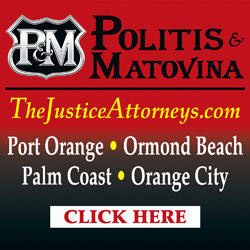
With some pushback from the Flagler Home Builders Association but notable unanimity from the dais and no complaints from the public, the City Council today approved sharply increasing fire, parks and transportation impact fees in hopes of further shifting the burden of development toward new residents. Last year the council did likewise with water and sewer impact fees.
The fire and parks impact fee ordinance was approved on second reading, enacting it. The transportation impact fee, after a few more wrangles, was approved on first reading, but is expected to be approved in two weeks on second reading. The new fees kick in on Oct. 1.
Impact fees are the one-time fee builders or developers pay once they complete a house or a commercial, institutional or industrial structure. Impact fees are intended to defray the “impact” of new development and new residents or businesses on infrastructure, including schools, parks, fire and library services. They are levied only on new construction on the principle that new residents will occupy those houses, and to some extent new businesses. The costs are typically passed down to the buyers of the new property and built into the overall cost. (See the briefing here.)
The fire impact fee is rising 117 percent to $942 for a single-family house, and to $1,495 per 1,000 square feet for non-residential buildings, a 114 percent increase. Revenue will help build new fire stations and buy new (but not replacement) fire trucks.
The parks fee will increase to $3,164 for single-family houses, a 73 percent increase. It is not levied on businesses or institutional buildings on the assumption that families with children living in houses use parks. Xerox machines in offices do not. Revenue is to pay for a new recreation center, a cultural arts facility expansion in Town Center, near the future YMCA, and a clubhouse and event center at the Palm Harbor Golf Club.
The transportation impact fee went through a few changes that lowered its cost. For example, U.S. 1 improvements were removed from the list of future projects and to apply a different fee based on the size of houses, rather than a flat fee. That brought the overall cost of the play from $124 million to $101 million, lowering the fee.
Under that calculation, houses would be charged in increments of 1,000 square feet. A 1,000 square foot single-family residential house or apartment would pay $3,770. A 2,000 square foot unit, the more typical size of houses in Palm Coast, would pay $7,540–a 115 percent increase over the current fee (down from 137 percent in the original proposal). The increase on a 1,600-square-foot unit would be 72 percent.
The higher costs for bigger houses and lower costs for smaller houses “is one way a number of communities are looking at to at least help address the affordability issue,” Jonathan Paul, a principal with New Urban Concepts, the city’s consultant on the issue, said. “Doesn’t solve it, doesn’t meet all the needs that are out there, but it’s at least one step in that direction.” The larger the house, the larger the impact on roads and streets. “Does that apply to every single home built in the city? No, but on average, that is what the data shows us,” Paul said.
Transportation impact fees will rise a built more for institutional construction such as churches, assisted living facilities, hotels, health and fitness clubs and the like, as well as for industrial construction. (The increases are in the 130 to 145 percent range.)
Council members were surprised that ITT-platted lots in Palm Coast’s older sections have been paying somewhat lower transportation impact fees than new subdivisions. That will not continue: The council ended the exception.
Transportation impact fee revenue may be used anywhere in the city to add to travel lanes, to add turning lanes, to add to traffic signs, to build new bridges or new sidewalks–but not to repair existing roads or sidewalks, or to repave existing roads.
Florida in 2021 enacted HB337, a law that corrals impact fee increases. Increases of 25 percent or less must be spread out over two years. Increases of 25 to 50 percent must be spread out over four. Increases of more than 50 percent are prohibited–with an exception, in case of extraordinary circumstances.
A local government has always been required to prove the calculated need for impact fees through a study. It must also prove that extraordinary circumstances exist–that the population is increasing faster than the state average, and that it’ll continue to grow faster. The city must also show substantial increases in construction costs. The council had no issue determining that in every impact fee proposal, it was facing extraordinary circumstances.
Annamaria Long, the executive officer of the Home Builders Association, challenged the findings. “Our forecast from 2020 was higher than our forecasting for 2025, which indicates that we now have a weakened nexus, and that is inconsistent with the proportionality requirements that the extraordinary circumstances require,” Long said. Construction costs alone are not sufficient to justify extraordinary circumstances. The law requires that “the extraordinary circumstance be severe, unforeseen and local,” which no longer applies, she said.
Council member Theresa Pontieri, describing herself as “staunchly” behind the fee increases, countered Long’s analysis, citing Palm Coast as still one of the more affordable cities for working families in housing costs.
“When we’re looking at all of these statistics and we’re trying to make sure we’re finding that sweet spot where we’re paying for growth, making sure infrastructure is taken care of, but also making sure that we remain an affordable place for working families and all of our essential workers to live,” Pontieri said, “I really do feel this is that sweet spot. So again, just hoping that this is the vote that takes place and that we get it done, not only this reading, but also the next reading.”
The vote was unanimous, as were the votes for the fire fee and the parks fee.
The impact fee increases appear to have missed the bulge of the boomlet of 2018-2024 development that caused a backlash among residents and played a significant role in causing a majority of the council’s members to lose elected office. But new construction continues at a solid, if slightly diminished, pace.





























Dusty says
Well it is about time instead on sticking us with it.
Chum says
@Dusty —They will still find a way to “stick it on us.”
Alex says
This will be passed 100% to the owners. All impact fees are passed on to the homebuyers the builders never pay them. If the impact fees goes up by $10k the home price just went up by $10k
Atwp says
Will it stick?
Pig Farmer says
Well, it is a good start.
A Resident says
Now if the council would stop approving 40 foot lot width’s that would be another win.
Urban Sprawl says
If our mayor didn’t fight for this we would still be dumping all of our raw sewage into the woods in perpetuity, and property owners would be footing the bill for the financial consequences of unchecked urban sprawl forced on us by a corrupt board of commissioners lining their pockets with the builders special interest money.
My thoughts says
Stop with the house building. I looked up a builder in my neighborhood and the one builder must have over 200 homes being built in Palm Coast, can only imagine what number the other builders have.
This is getting out of control for this town, and my question is why the City of PC is allowing this when the size of this area isn’t equip for it.
The streets traffic is being belief; the sewers can’t handle it. The City of PC is destroying the city right before our own eyes.
Ric Scott says
Republicans can no longer claim to support lower taxes due to spending and taxing people uncontrollably.
Miami North says
Something like a Day late, and a dollar short
Local says
We will be a land of condos just like South Florida before long. Young people are not going to be able to afford to build houses. Even used house prices will be through the roof.
Gregg says
Too little too late, the area is a zoo, council members are rich from the developers payouts ! We have no wildlife of woodlands. Palm coast is in shambels!